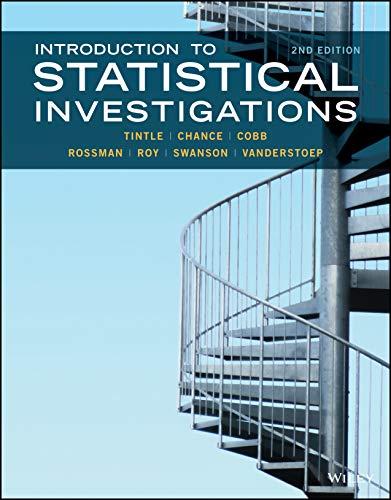Seagulls are notorious for stealing food from people. Will staring at them be a deterrent? Researchers (Goumas
Question:
Seagulls are notorious for stealing food from people. Will staring at them be a deterrent? Researchers (Goumas et al., 2019) set French fries in a sealed plastic bag on the ground and then crouched down about 1.5 meters away. When a seagull was spotted approaching the food from the ground, they started a timer. A researcher would either stare at the seagull or look away while the seagull approached. Time was recorded until the seagull grabbed the bag of fries. The researchers were able to collect data on 19 gulls, where one time the gull was stared at and one time it was not. The order in which these happened (staring or not) was randomly determined. While they made sure that the same seagull was used twice, once stared at and once not, they also tried to make sure no seagull was used more than twice. The times, in seconds, it took the seagulls to get to the food are in the file Seagulls. (In the file, Away is when the researcher looked away and At is when the researcher looked at the seagull.)
a. Put the data into the Matched Pairs applet and run a one-sided simulation-based test to see if seagulls spend more time, on average, getting to the food when they are being watched. Give the statistic (and describe what it is measuring), a p-value, and a conclusion.
b. Notice in the data that there are 6 times (all when the seagulls were looked at) that are 300 seconds (or 5 minutes). The researchers decided to stop timing at 300 seconds, so these seagulls were approaching the food, but never got there in the allotted time. Because these are not actually the times it took the seagulls but more like cutoff values, it might make sense to throw them out. However, as the actual times are even higher, it might make sense to leave some big number in there, like 300. To avoid this dilemma, we could do this another way and just categorize our data by making a success to mean that the seagull took more time to go to the food if it was stared at and a failure to mean that it took less time to do so. This way we are changing a quantitative response to a categorical one. While this leads to the loss of some information, we don’t have any problem that the 300 isn’t exact and don’t need to leave out these numbers from our analysis. We just need to know how often the seagull took longer when looked at rather than not. In categorizing our data, what is the proportion of the 19 times the seagulls took longer to get to the food when stared at? (This is your sample proportion.)
c. What kind of test would you run to test your proportion from part (b)? Run this test, again using an appropriate one-sided alternative hypothesis. State the null and alternative hypotheses, report the statistic and p-value, and state a conclusion in the context of the study.
d. How do your results from parts (a) and (c) compare?
Step by Step Answer:

Introduction To Statistical Investigations
ISBN: 9781119683452
2nd Edition
Authors: Beth L.Chance, George W.Cobb, Allan J.Rossman Nathan Tintle, Todd Swanson Soma Roy





